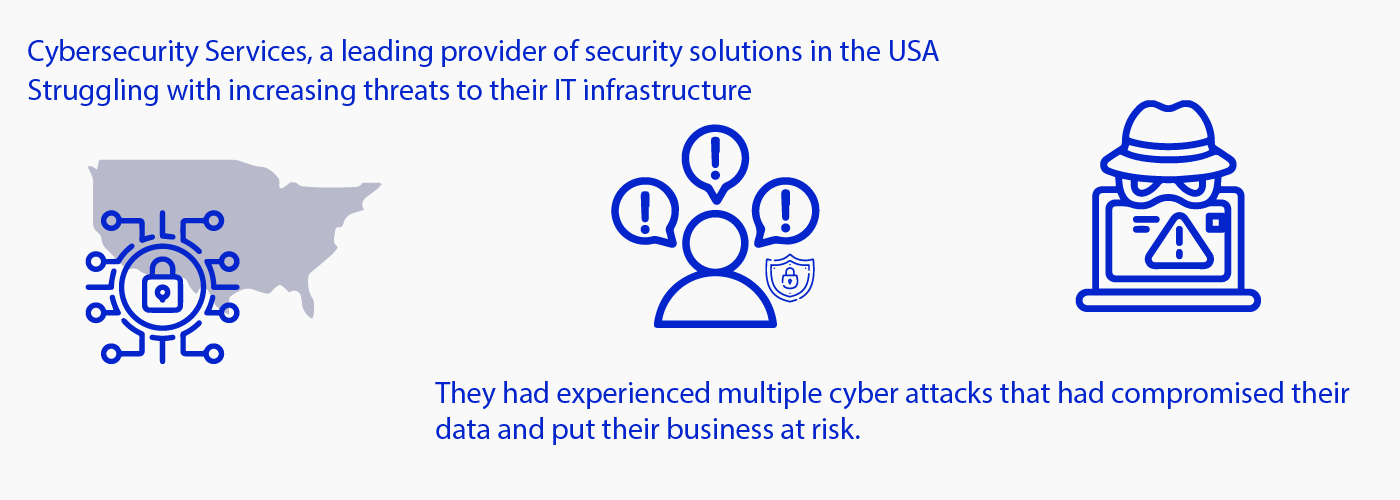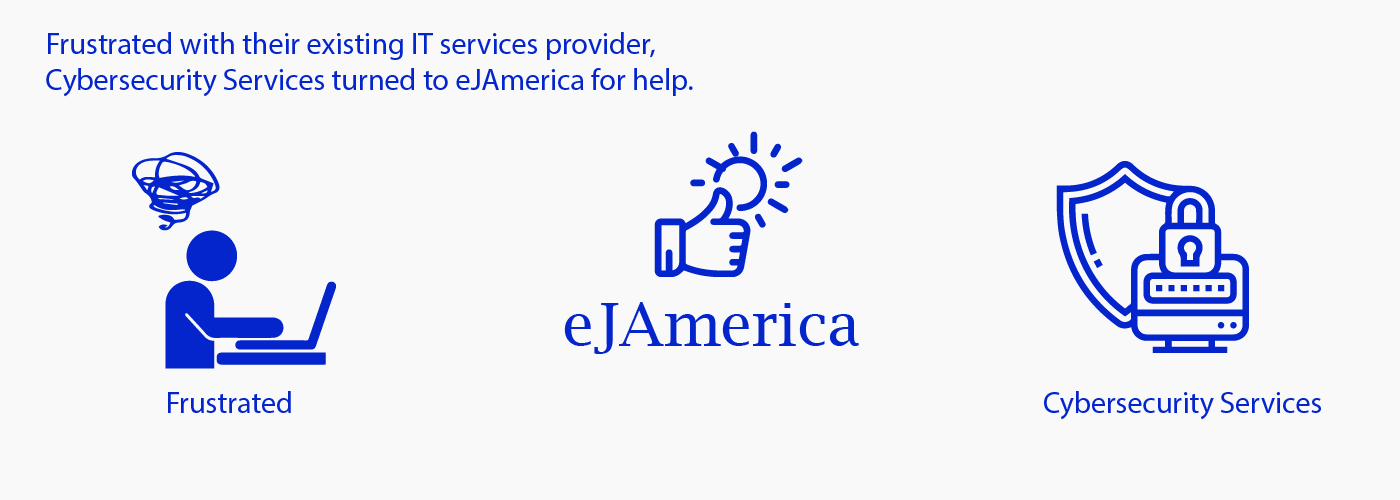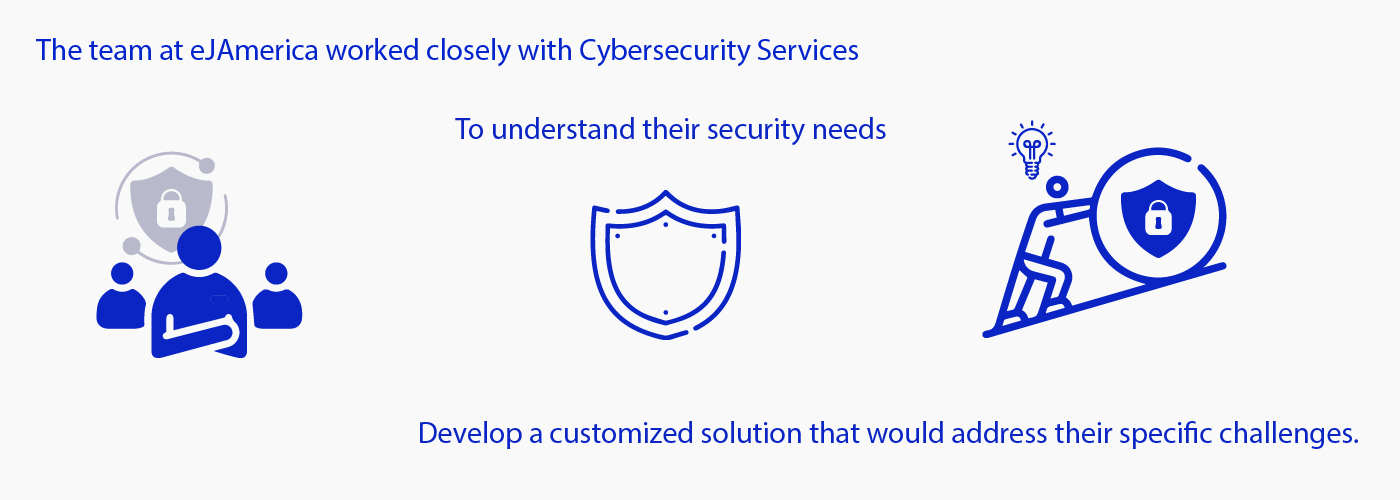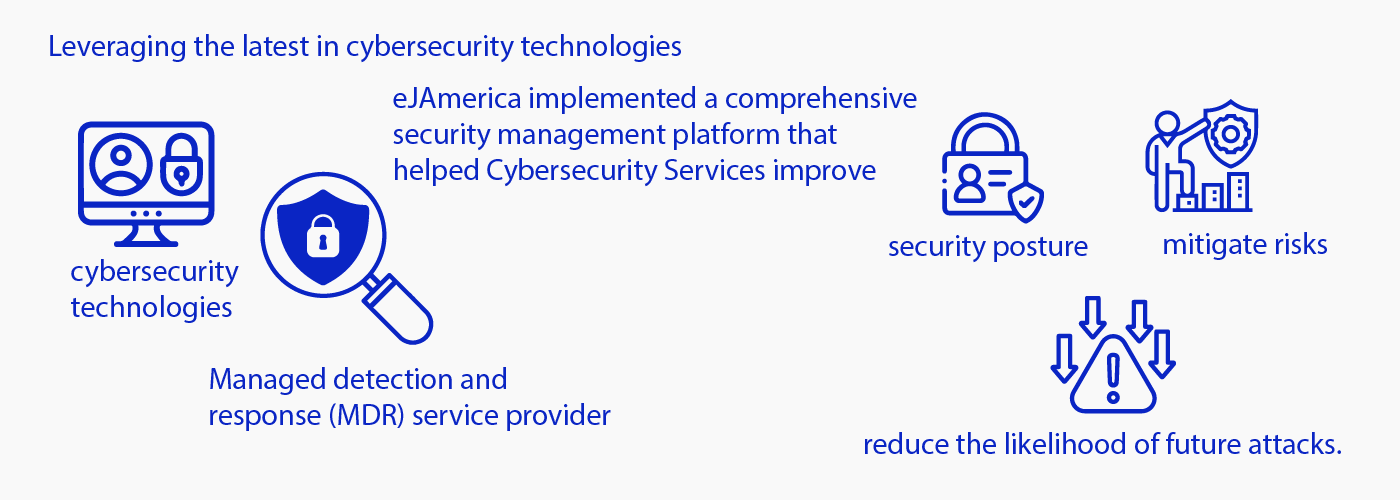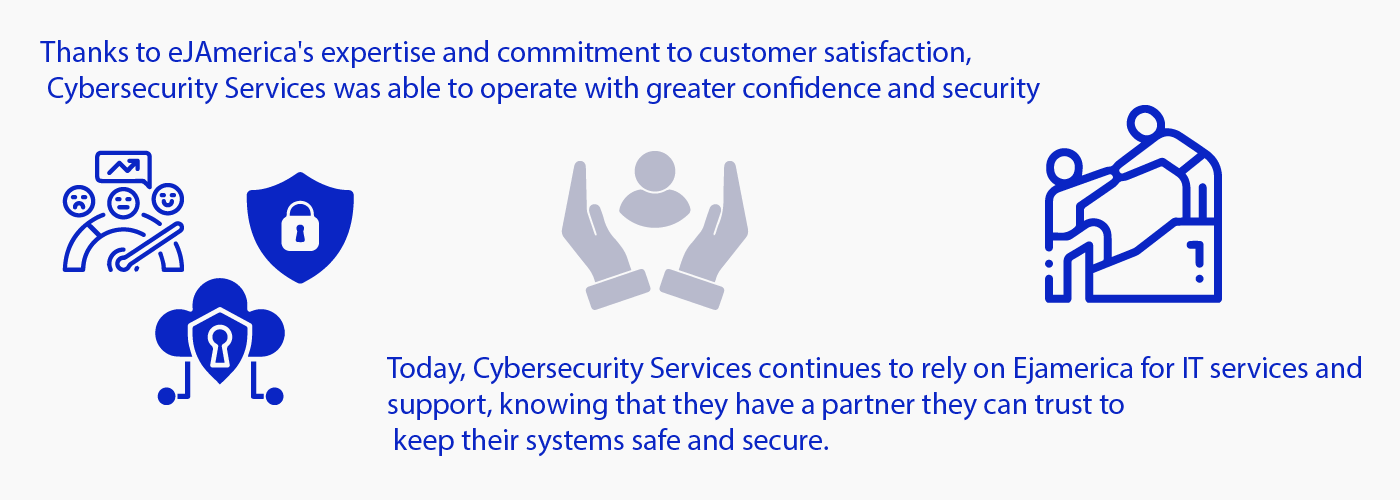Cybersecurity Services
There are a number of cybersecurity services that eJAmerica offers. We are technology agnostic and can support any Cybersecurity OEM products including Splunk, Qualsys, QRadar, RSA, Crowdstrike, Cyberark, Okta, OneLogin etc to name a few. Some of the best and most in-demand services include:
- Network security: This includes services such as firewall management, intrusion detection and prevention, and vulnerability management.
- Endpoint security: This includes services such as antivirus and anti-malware protection, endpoint encryption, and device management.
- Cloud security: This includes services such as cloud access security broker (CASB) solutions, cloud-based firewalls, and cloud security posture management.
- Identity and access management (IAM): This includes services such as multi-factor authentication (MFA), identity governance, and privileged access management.
- Managed Security Services: This includes services such as security incident and event management (SIEM), threat intelligence, and vulnerability scanning.
- Compliance and Risk Management: This includes services such as regulatory compliance assessments, vulnerability assessments, penetration testing, and incident response planning.
- Security Training and Awareness: This includes services such as security training and awareness programs to educate employees on how to identify and prevent cyber attacks.
It’s important to note that cybersecurity is a rapidly evolving field, and new threats and technologies are constantly emerging.eJAmerica stays up-to-date with the latest cybersecurity trends and best practices in order to provide the best possible services to their clients.
Managed detection and response (MDR) service provider
eJAmerica, as a managed detection and response (MDR) service provider, can help organizations establish or enhance their threat detection and incident response strategies.
It can also help avoid the traditional obstacles associated with deploying advanced security infrastructure and hiring skilled security professionals. Organizations of all sizes can take advantage of MDR services to quickly scale their security and compliance efforts—often with greater cost-efficiency and a faster ROI than doing it on their own.
The MDR market is proliferating. Many managed security service providers define their own MDR service offerings based on their current capabilities and infrastructure. With so much variation in service definitions, it can create confusion about what MDR does or does not provide to customers. At a minimum, MDR services will provide 24×7
alarm monitoring and at least some lightweight incident investigation and response. But, as with any swiftly maturing market, a customer’s mileage may vary. It pays to do a lot of due diligence before settling on a managed security services provider (MSSP) or MDR provider. That evaluation should look into the quality of service offered and the technologies underpinning the service. Organizations evaluating the MDR market should consider the following 10 elements in their decision-making process
As with any managed security service, it’s important to “look under the hood” to evaluate the security technologies that the MDR provider uses to perform threat detection and incident response. A thorough technology evaluation can help you determine how broad and potentially effective the MDR provider’s threat detection capabilities may be. It can also help you identify technical limitations or gaps that may require you to supplement the service with other security controls.
Some MDR solutions on the market today are based on a single-security technology, such as endpoint-based detection and response (EDR). This may limit the visibility the service provider has into the threats facing your critical infrastructure. Organizations should seek out an MDR solution that uses multiple detection technologies that work together for effective detection and response across networks and endpoints. Look for an MDR solution that delivers essential security capabilities, such as asset discovery,
vulnerability assessment, network- and host-based intrusion detection, and SIEM correlation. The solution should also have capabilities like user activity monitoring and dark web monitoring. An MDR service that combines multiple integrated security capabilities can help provide broad threat coverage and early detection and can help to reduce false positives. It can also enable the MDR providers’ security analysts to gain important threat context quicker in an investigation—which can lead to a faster containment time.
MDR buyers invest in managed security services in order to buy time — speeding up response time and minimizing time spent on building out detection and response capabilities or staff. Deployment times are a big consideration. Every day it takes to implement a solution is an extra day the business is exposed to risk. Not only that but when it comes time to prove ROI to the business, those metrics can be greatly skewed by lengthy deployment schedules. We provide upfront deployment timelines. How long does it take to get technology in place and the service up and running? Don’t be fooled by marketing hype by others. We can prove our claims by providing customer references who can corroborate such timelines.
Increasingly, security programs are incorporating security orchestration, automation, and response (SOAR) tools to improve efficiency and response time to incidents. Even if you enlist an MSSP to manage your threat detection and incident response program for you, the use of orchestration and automation can help to improve the efficacy and efficiency of the service. At a minimum, we will be able to automate continuous data collection and security analysis for near-realtime threat detection across your environments. Going further, we use advanced security orchestration capabilities and pre-built integrations with other essential security tools that can help accelerate and ease incident response activities. We are able to automate or orchestrate security policy changes on your firewall after detecting an activity with a known malicious IP address, regardless if you manage the firewall or the MSSP manages it for you.
MDR is not an outsourcing arrangement in the traditional sense and should not be performed in black-box conditions. Even with an MDR provider at your side, your security team owns your overall security program—they will likely participate in the security monitoring activities at some level.
Cloud & Infrastructure Security
As organizations adopt public cloud services and infrastructure, protecting those environments is of utmost importance. In today’s hybrid IT environments, organizations must be able to monitor critical assets whether they are in the data center or in the cloud. MDR solution should provide that visibility by default. Some MDR providers may be limited in their support for cloud security monitoring. Or, they may require you to upgrade your service or purchase an additional service module. These limitations may hinder your cloud transformation or result in unforeseen, additional costs. If you’re not currently using cloud infrastructure or services today, having a solution that is ready to support your future cloud migration can save you time and costs. It can also simplify things for you if you don’t have to change your service or MDR provider when it’s time to migrate. We are a provider that offers native cloud security monitoring for your business-critical IaaS and SaaS environments as part of their MDR solution by default. These capabilities should integrate virtually seamlessly with our network security monitoring for centralized visibility across networks and endpoints on-premises and in the cloud. Additionally, MDR will be able to identify security configuration errors and other vulnerabilities in your cloud environments. Based on their findings, we should be able to provide recommendations for improving your cloud security posture.
Threat Intelligence
Threat detection technologies and security analysts are only as good as the threat intelligence that fuels their work. Thus, the quality of the threat intelligence that powers our MDR service should be no secret. Evaluate the quality of your threat intelligence based on diversity, timeliness, and resilience. Evaluators should probe into the sources of
threat intelligence that powers their MDR provider’s detection capabilities. Look for diversity in those sources and ask the provider if they use a variety of threat intelligence sources or rely on a single source. If a provider is at all vague about their threat intelligence sources, those could be potential red flags for buyers. In addition, pay attention to how soon your defenses are updated after a new exploit or vulnerability is discovered in the wild and the frequency of threat intelligence updates. Finally, evaluate the threat intelligence for its resilience. Threat intelligence that helps to identify higher-order tools, tactics, and procedures (TTPs) promotes resilient detection, as TTPs are less
likely to change frequently than indicators like IP addresses and file hashes. Carefully examining the diversity, timeliness, and resilience can help you to determine the quality of the threat intelligence.
Compliance
Common market definitions for MDR services place compliance reporting out of scope. However, with all the functions commonly provided by MDR standing as key areas under many regulators’ purview, it’s important to be able to get the visibility and report your need to demonstrate compliance during an audit. The right MDR provider could help to provide invaluable support for your compliance readiness efforts. We offer a consolidated reporting view of regular vulnerability scans, malware
detection, collection of firewall logs, file integrity monitoring, and incident response habits. Customers can get more bang for their MDR buck if they seek out a provider that will assist with their compliance reporting needs. Also, make sure the MDR provider has earned its own compliance certifications, such as for PCI DSS, SOC 2 Type 2, and ISO 27001. Doing so can give customers confidence in working with a service provider that understands and can successfully navigate the compliance process.

Scalability
Today’s IT environment moves fast to keep pace with business demands. With the coming tide of digital transformation, an organization can’t afford to be slowed down by security constraints. Before signing on the dotted line, MDR customers should think about whether their provider is ready to support their organization’s growth and IT
transformation. Look for an MDR solution that offers speed and simplicity in scaling. Whether you plan to expand your footprint with new satellite offices or retail locations, merge or acquire another company, or otherwise grow your IT environment to keep up with business demands, you should be ready to extend your security coverage without complex change orders or lengthy deployments. Understanding the costs of scaling your MDR service is equally as important. Pricing should be transparent, and customers should look closely to see that there aren’t limitations on events per day (EPD), user seats, or the number of assets monitored. These can limit flexibility and cause cost overruns. Customers should ask for information about the MDR provider’s architecture and ask tough questions not only about the costs of monitoring today’s environment but also about what it’ll take to scale up as your environment grows.
Our Security Operations Center can be in the USA, AU, Mexico, or India.
